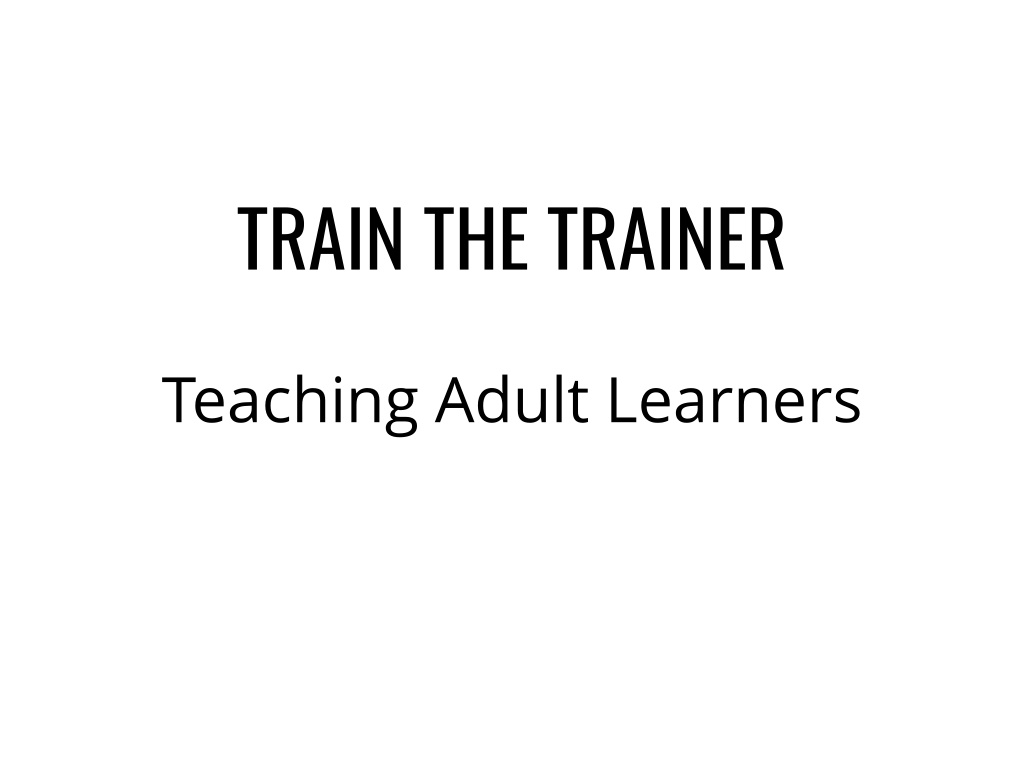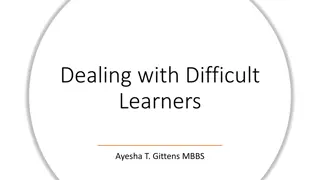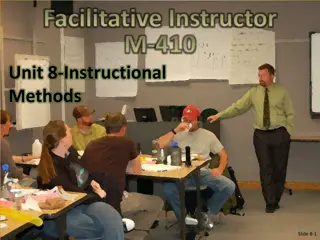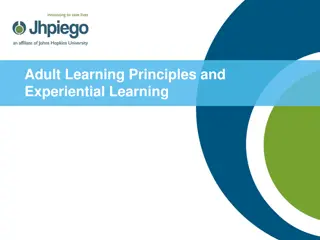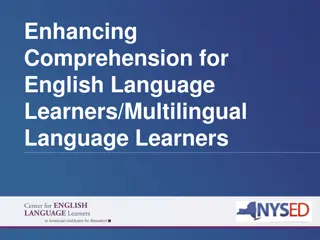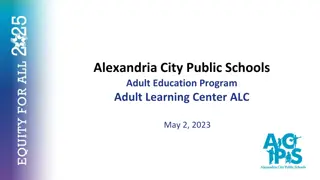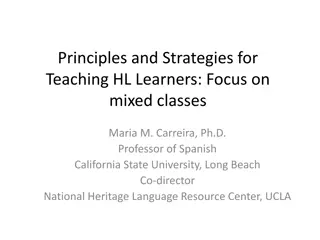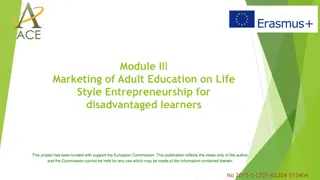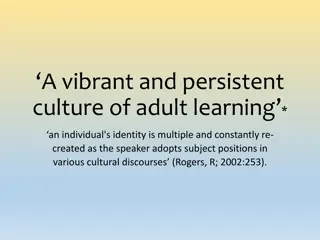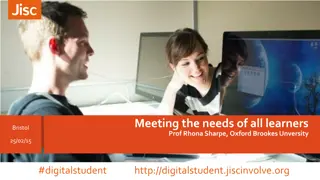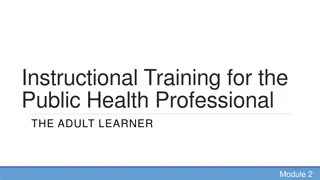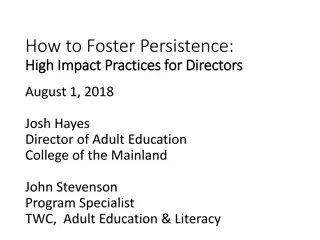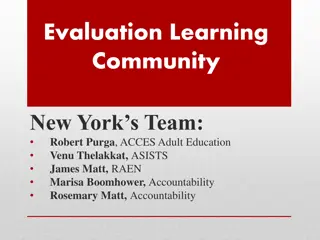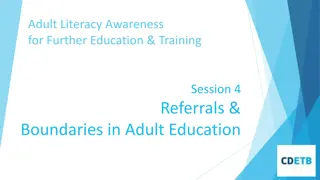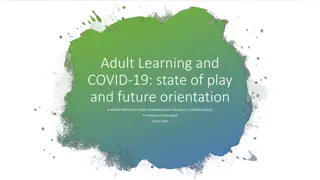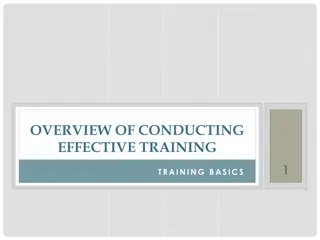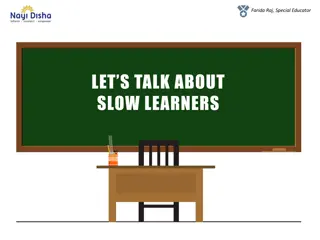Understanding Adult Learners: Key Characteristics and Strategies
Characteristics of adult learners include being goal-oriented, self-directed, valuing past experiences, desiring respect, and having established habits and opinions. Understanding these traits is essential for effective teaching and training. Adult learners seek practical information, immediate feedback, and a say in their learning process. Instructors should create a supportive and respectful environment that values learners' input and relates new information to their prior knowledge.
- Adult Learners
- Teaching Strategies
- Self-Directed Learning
- Respectful Environment
- Learning Experience
Download Presentation

Please find below an Image/Link to download the presentation.
The content on the website is provided AS IS for your information and personal use only. It may not be sold, licensed, or shared on other websites without obtaining consent from the author. Download presentation by click this link. If you encounter any issues during the download, it is possible that the publisher has removed the file from their server.
E N D
Presentation Transcript
TRAIN THE TRAINER Teaching Adult Learners
Characteristics of Adult Learners Goal oriented They bring specific habits/ opinions to the learning process Approach new learning based on past learning experiences Self directed They relate new information to prior knowledge and experiences Expect to be active participants in learning Want to be treated with respect
Goal Oriented Adult learners are goal oriented and bring specific expectations to the learning situation Want information they can understand and put into practical use right away Need immediate feedback so they can know whether or not they understood the information just given to them
Self Directed Need to be able to direct their own learning Learning is a guided self discovery process Must have a say in what they are being taught
Past Learning Experience Have experienced a wide variety of training in the past both positive and negative Instructors must consider the past experiences of adult learners in designing and delivering their training or evaluations.
Need for Respect Need to feel respected for what they know and be treated as adults Learn best in a safe and supportive environment Should be treated as equals in experience and knowledge and be allowed to voice their opinions respectfully Adult learners should be corrected or coached in a positive way that shows respect for the individual
Established Habits and Opinions Already have set behaviors May resist learning if they feel their behaviors are being challenged or criticized Need to feel that their ideas and opinions have value and weight Good instructors take advantage of the learners experiences to improve training techniques.
Relating to Prior Knowledge Tend to make connections with information or knowledge they already have learned Effective instructors relate new information to situations which trainees are familiar to make new knowledge less threatening.
Active Participants in Learning Need to participate in the learning process. Effective instructors need to be aware of adult learners attitudes, past experiences, habits, and opinions in order to understand their perspectives. Success in learning stimulates the desire for additional learning.
Four Ways Adults Learn Differently They may: Think about it first/ analytical Watch / observe first Try handson first Use trial & error first Each adult learner has a preferred way to learn
Four Phases of Learning 1. Introduction to new information 2. Assimilation of the newly acquired information with previous knowledge and experience 3. Translation of the new information combined with past experience into specific knowledge 4. Accumulation of experience through practice, trial and error, and feedback on performance
Teaching Adult Learners No one trainee is the same Every adult has a preferred style of learning The instructor must be able to recognize and adjust to the different learning styles.
Presenting Information Establish strong personal contact Encourage student involvement Give praise, recognition, and approval Display enthusiasm and excitement Encourage learners support of one another Maintain clear and open communication Speak clearly and concisely Use examples and illustrations Attend to non verbal clues/ body language Consider causes of conflict Check your acceptance of cultural and generational differences
Presenting Information People learn faster by seeing and hearing than by hearing alone. People learn even faster when doing is added to seeing and hearing. It is doing that makes learning permanent. People tend to remember what they did in training, rather than what they were told in training. Adults learn best by doing!
Presenting Information Demonstrating Coaching Storytelling
Demonstrating Learners can see what is being taught. The action holds the learners attention. Completion of the activity shows performance standards and procedures. The demonstration reduces the potential for later trial and error learning Demonstration can help show abstract points. Shows how to perform a task. Adults learn best by seeing , hearing and doing!
Coaching Creates a positive learning environment. Offers feedback from an experienced source ( the instructor/coach). Helps discover and expand learners comfort zones through: Guidance Reinforcement Support Correction
Storytelling The story should apply to what is being taught and be appropriate Told at the right time Powerful teaching tool Group Exercise: You have been instructing a student in proper braking technique for slippery surfaces or downhill grades. Provide a story for your student.
Communication Skills Listening and responding not just hearing Listening! Nonverbal communication
Listening Stop Talking! Establish eye contact. Show you want to listen. Complete attention on the trainee. Try to see the situation from their point of view. Be patient, hold your temper or criticisms. Ask questionsshow interest in what they are trying to say.
Nonverbal Communication Accounts for 90% of communication. Body Language: Facial expressions Gestures Tone of voice Vocal cues Body position Examples / Situations
Communication Skills Establish eye contact Hear yourself repeat the idea/ thought the person is trying to convey Let the person speaking know that you understand Check or clarify accuracy Encourage more discussion Focus on key words, main ideas, and visual images or examples Ask questions if what the other person is saying is not clear or complete
Communication Skills Interjecting nonjudgmental feedback into a conversation: Clarifying: get the other person to explain something that was not clear. Ex: I don t understand what you mean or Would you repeat that again .
Communication Skills Paraphrasing: repeat what the other person said, but in your own words. Ex: Let me see if I am with you .You said or In other words you think or What I hear you saying is ..
Communication Skills Summarizing: put a number of points into one sentence. Ex: What you have said so far is .. or As I understand it, your key point is ..
Avoid Bad Listening Habits Assuming in advance what the person speaking says will not be interesting or rewarding Mentally criticizing the way the other person speaks instead of listening to the words Concentrating on small details and missing the main ideas Pretending to pay attention but thinking about something else Letting prejudice against appearances, words, or phrases block your receptivity to the speakers ideas.
Reinforcing Behavior Positive Reinforcement Negative Reinforcement Extinguishing Behavior
Positive Reinforcement Reward: Words Actions Phrases Don t overuse
Positive ReinforcementWords Yes Good job Nice Outstanding! Great Excellent Beautiful Right Terrific Awesome! Exactly Super Correct Remarkable
Positive ReinforcementPhrases Fine answer. That s true. All right. Good response. A good way of putting it. Right on! That s clever. You performed well. Very well done. You re doing better! You are improving. That s interesting. That s the best yet!
Positive ReinforcementActions Looking at the learner. Smiling Nodding Laughing happily Clapping hands Signaling okay Raising eyebrows/smiling Walking towards the learner to talk to them Thumbs up!
Other Positive Reinforcement Ask the learner to show what he is doing Asking the learner to explain something to someone else Using the learner as a model of correct performance Asking the learner to participate in a demonstration Giving the learner some free time
Positive Reinforcement Summary Positive reinforcement is something that increases the probability of the behavior being repeated. It is usually something the learner likes or wants. Positive reinforcement must follow the desired behavior not precede it. Reinforcement should follow the behavior as soon as possible At first, the reinforcement should be given for every correct behavior, then less frequently Reinforcement should be omitted when the desired behavior does not occur.
Negative Reinforcement Punishment Phrases Nonverbal expressions Use carefully
Negative Reinforcement Action taken immediately after certain behavior which discourages repetition of the behavior Usually something the learner does not want or like and is considered punishment May have serious unwanted side effects if used carelessly or insensitively avoid frequent use of it in instructional settings
Negative Reinforcement If a situation calls for negative reinforcement, it should be followed by or coupled with some form of positive reinforcement Negative reinforcement should be used sparingly and carefully Some signs of disapproval are comments like that was dumb , grimacing facial expressions, or ridicule.
Negative Reinforcement Negative reinforcement is a form of punishment, and if an instructor becomes associated with punishment, your effectiveness can be greatly impaired. Build a strong relationship with your learners, using mild negative reinforcement to spur them to a greater effort.
Negative Reinforcement Spoken phrases: That s not exactly correct You need to think that through again You can do better than that Non verbal expressions: Looking disappointed Shaking your head Frowning
Negative Reinforcement Negative reinforcement when used sparingly and coupled with positive reinforcement can have help develop a good relationship with your learners and help them see what the expectations are, how they are doing with the tasks being taught, and developing respect for the instructor. All negative reinforcement should be used with respect for the adult learner
Extinguishing Behavior Extinguishing behavior is the planned absence of reinforcement Ex: an instructor sets a rule or guideline in a class/group. A student ignores the rule or guideline. The instructor ignores the student not following the guidelines and recognizes another student who is following it. Ignoring the behavior Requires time and patience
Resolving Conflicts Managing Anger: Some thing caused anger, not some one . Preventing Conflicts: Discuss potential conflicts first. Conflict Resolution (Mediation): Separate, control, mediate.
Train the trainer Assessing student learning: Did you teach? Did they learn? Did you document?
Assessing Student Learning Evaluating Scoring Documentation Using Instructor Forms
Evaluating Evaluating their performance: How did they start out? How did they end? Evaluation as a teaching tool. Evaluation as an instructor tool.
Scoring It is what it is . Scoring Their Performance: What they did. Leave emotions out. Consistency: Your scoring Other Instructors scoring.
Documentation If it wasn t recorded, it didn t happen . Leave emotions out What you observed: Significant strengths Areas in need of improvement Recommendations
Summary Teach with respect. Teach with enthusiasm. Always be kind and respectful to all students. Be the example of professionalism. Give more than you take. You are changing peoples lives.
